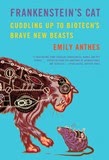by Emily Anthes, science journalist and author
I’m thrilled that my book, Frankenstein’s Cat: Cuddling Up to Biotech’s Brave New Beasts, has been selected for the Research Ethics Book Group Lunch at this year’s IACUC Conference. I will be on hand at the conference to answer questions and help lead discussions about the book. I thought I’d take this opportunity to provide a short introduction to the book and its themes.

Frankenstein’s Cat offers a wide-ranging look at how biotechnology provides us new tools to reshape animal bodies and brains. My definition of “biotechnology” is fairly broad, and I cover a wide range of scientific developments, including:
- Cloning: Reproductive cloning remains an experimental technology, but scientists and entrepreneurs are already finding several applications for it. Pet owners who can afford the six-figure price tag can get their dogs cloned in Korea, several hundred cloned farm animals are born in the US every year, and a research facility in New Orleans is making a name for itself by cloning endangered cat species.
- Gene therapy: Researchers have cured one type of hereditary blindness in dogs by injecting a critical gene into the canines’ eyes.
- Pharming: Farm animals—especially goats—are being genetically engineered to produce pharmaceutical compounds in their milk. The drugs can be extracted from the milk, processed, and prescribed as treatments for a variety of serious diseases.
- Prosthetics: Thanks to advances in materials science and veterinary science, engineers have built a new tail for a dolphin, foot for an elephant, and beak for a bald eagle. A handful of cats and dogs have even received bionic limbs—prosthetic devices that are permanently implanted in their bodies.
- Cybernetics: By implanting electrodes in the brains of beetles and rats, scientists have created remote-controlled, cyborg critters that can be steered through space. The cyborgs could be used to conduct surveillance or locate survivors of natural disasters.
As I discuss these and other advances, I also examine the ethical issues they raise, considering the implications for humans, animals, and the environment.
As I write in the book’s introduction:
“Now that we can sculpt life into an endless parade of forms, what we choose to create reveals what it is we want from other species—and what we want for them. But even if you feel no special affection for the creatures with whom we share this planet, our reinvention of animals matters for us, too. It provides a peek into our own future, at the ways we may start to enhance and alter ourselves. Most of all, our grand experiments reveal how entangled the lives of human and nonhuman animals have become, how intertwined our fates are. Enterprising scientists, entrepreneurs, and philosophers are dreaming up all sorts of projects that could alter the course of our collective future.
So what does biotechnology really mean for the world’s wild things? And what do our brave new beasts say about us?”
I look forward to discussing the book with many of you at PRIM&R’s 2014 IACUC Conference.


No comments! Be the first commenter?